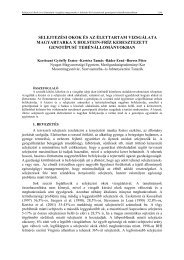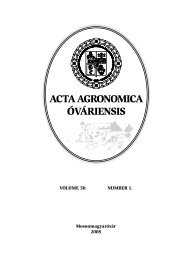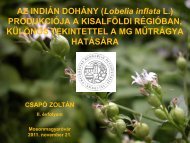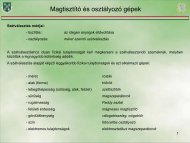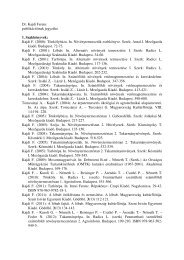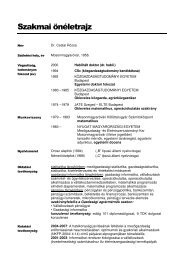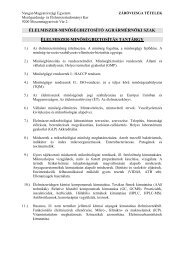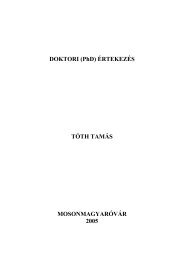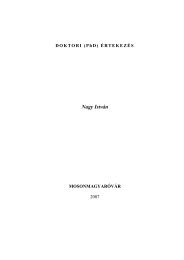teljes anyag - Nyugat-Magyarországi Egyetem Mezőgazdaság
teljes anyag - Nyugat-Magyarországi Egyetem Mezőgazdaság
teljes anyag - Nyugat-Magyarországi Egyetem Mezőgazdaság
You also want an ePaper? Increase the reach of your titles
YUMPU automatically turns print PDFs into web optimized ePapers that Google loves.
52N. Varga – E. Bertalanné Várallyay – L. Salamon:LITERATURE REVIEWSeveral factors influence the profitability of a dairy farm. Some of them cannot be influenced(e.g. milk price, energy prices, amortisation costs etc.), some of them can begreatly influenced (production level, udder health, fodder quality, rate of calf mortality,sperm costs, vet costs, spread of metabolic diseases etc.). Although it is often said that thehigher the performance level of the dairy farm the higher the yield per cow is, many ofthem doubt and strive to develop an ”optimal performance level” because that is ”cheap”(Elekk 2001).Rate of losses induced by different diseasesHungary is a full member of the European Union where competitiveness has a priority inthe agricultural policy. In order to meet these requirements one should reduce losses ofcattle stocks (caused by diseases) and establish a healthy stock. In Hungary main losses arecaused by different types of mastitis, fertility problems and metabolic diseases, differentinfections, e.g. virus diarrhoea (BVD) and infectious rhinotracheitis (IBR). These diseasescause considerable economic losses in countries with developed cattle farming, too.MastitisMastitis is an inflammatory process of the bovine mammary glands caused mainly bybacterial infections. After the infection of the mammary glands clinical mastitis or subclinicalmastitis may develop, which may go on without symptoms. Sub-clinical mastitisis more frequent it makes out about 70% of all mastitis diseases.Hungarian and foreign data confirm that mastitis diseases cause the highest economiclosses in stocks as a result of lower milk yield, premature culling and vet costs. Lowermilk yield and milk quality result in lower revenues caused by separating the milk of thetreated cows. Ózsvári et al. (2001a) calculated a yearly loss higher than 10 million HUFcaused by lower milk yield on a dairy farm with 1550 milk cows. Kovács (1999) estimatedlosses higher than one billion HUF per year for the cow stock in Hungary in 1999.Fertility problemsThe profitability of cattle breeding depends on the calving interval period. The shorterthis period is the more claves will be born and the higher milk yield can be expected. Thisperiod can be controlled by proper breeding policy based on adequate animal health andfertility situation. In Hungary this is one of the greatest problem of cattle breeding, whichhas not still been settled. The national average is about 420–430 days (Széles 1998), muchhigher than necessary, therefore breeders should do their best to achieve a period not longerthan 400 days. Szenci (1999) estimates if this period was 10 days shorter it would reducecosts by 2 billion HUF, although he does not consider the profit coming from calving andhigher milk yield.




